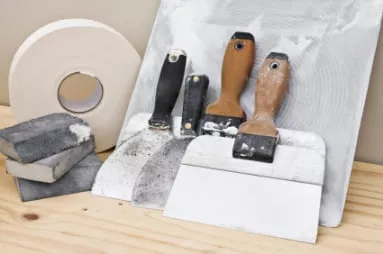Thanks for visiting the Drywall Materials page!
When selecting the drywall materials for your home improvement project there are a few factors that you must consider. It can be a little more complex than just stopping at the local hardware store and having them load up a few sheets of drywall.
It is nothing that you cannot handle, especially with our help. When selecting your materials you must take a few things into consideration.
The first item of consideration is what are you drywalling? Take a few minutes to think through the job at hand before purchasing your drywall materials.
In most states and cities you can simply use 1/2″ drywall on the walls and ceilings. Make sure that you check the codes in your area because in some areas local inspectors or codes require 5/8” Fire Shield drywall. Fire shield is usually needed in fire hazard areas such as an attached garage. 5/8 inch drywall is also more energy efficient for your heating and cooling saving you money money you can learn more abouthome energy savings projectsto further save your wallet.
Before we continue we have provided a small key to show all the different types of drywall.
- R– regular or standard drywall
- MR– moisture resistant drywall also known as green board
- FS– fire shield or fire resistant drywall as mentioned earlier
- F– flex board which conforms to curves (usually in 1/4” thickness)
The next consideration is will you be installing drywall around a sink or a shower where moisture be will present? If so you will want to use green board this will keep your drywall not only from molding but also falling apart in time.
They offer a 100 percent waterproof green board which is highly recommend for bathrooms and other high moisture areas. Further considerations may also be made for paint when waterproofing.
If you simply are going over a preexisting wall with drywall they make 1/4″ drywall. This is an option to give the look of drywall without the cost and weight of 1/2″ or 3/4″ drywall.
We highly recommend against this and suggest removing the current wall or ceiling and beginning the job with bare studs.
Now that you know what drywall materials are available we will discuss how they are sold. The standard drywall sheet is an 8’ x 4’ sheet which covers 32 square feet.
Drywall is also sold in 12’ x 4’ sheets covering 48 sq feet, offering a third more per sheet. Using 12’ sheets is convenient because it eliminates excess seams, and as you will find out, seams are where all of the time and work are at.
Next you will be purchasing mud anddrywall tapefor the seams. There are two types of tape – paper and fiberglass. In the past only paper tape was used, but many professionals have transitioned into the more user-friendly fiberglass tape.
Depending on what you would like to purchase both are available. We recommend using fiberglass tape because it more durable and easier to apply.
Surprise, surprise – drywall mud (or joint compound) is also available in various types. When purchasing drywall mud you will want to want a general all-purpose type for your first few coats.
You will not want experiment with fast drying mud especially on your first project. Simply purchase an all-purpose compound.
You have the option of purchasing aTopping Compoundfor your finishing coat (it is often listed asFinishing Mud). This is simply a finer-grained compound that allows for a smoother, less coarse finish.
Finally, you will need to purchase your drywall fasteners (drywall screws) to hang the drywall. You can purchase coarse or standard fasteners.
We suggest using standard screws and highly recommend against nailing drywall.
Nailing is a far less effective way to fasten drywall, and they have a tendency to “pop” after some time, destroying the finish of the drywall. Not only are screws more effective, but with the right tools they are also far easier to use.
To figure how much of each drywalling material you will need please check out ourDrywall Estimatorpage.
Here are a few links to more specific drywall materials pages that will give more in-depth info and recommendations.

